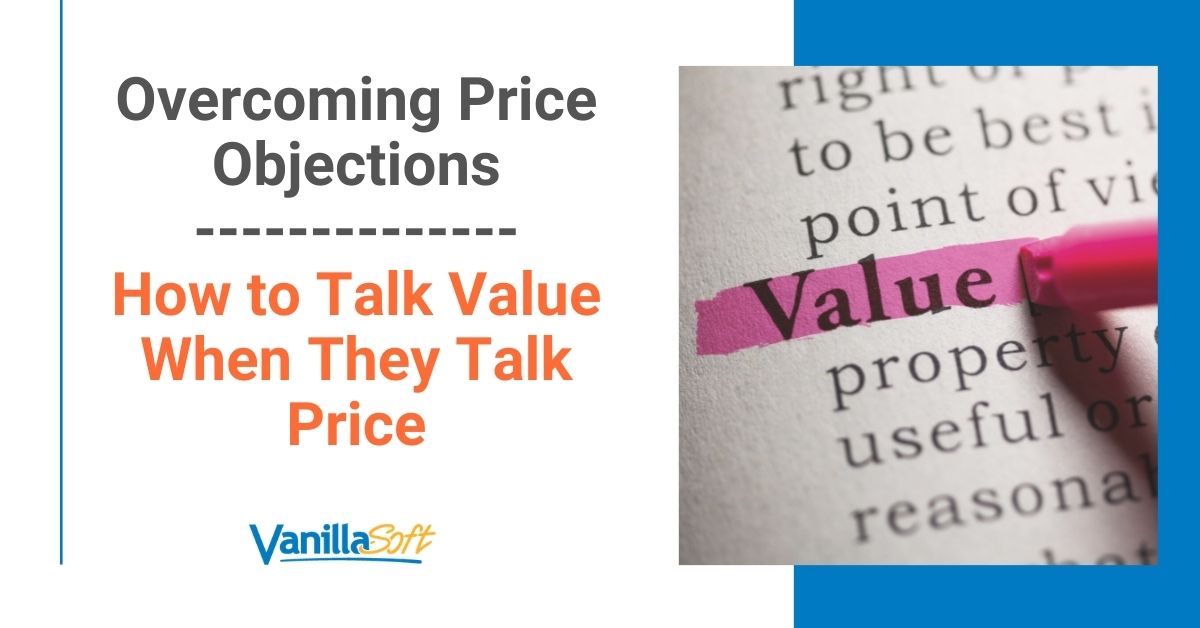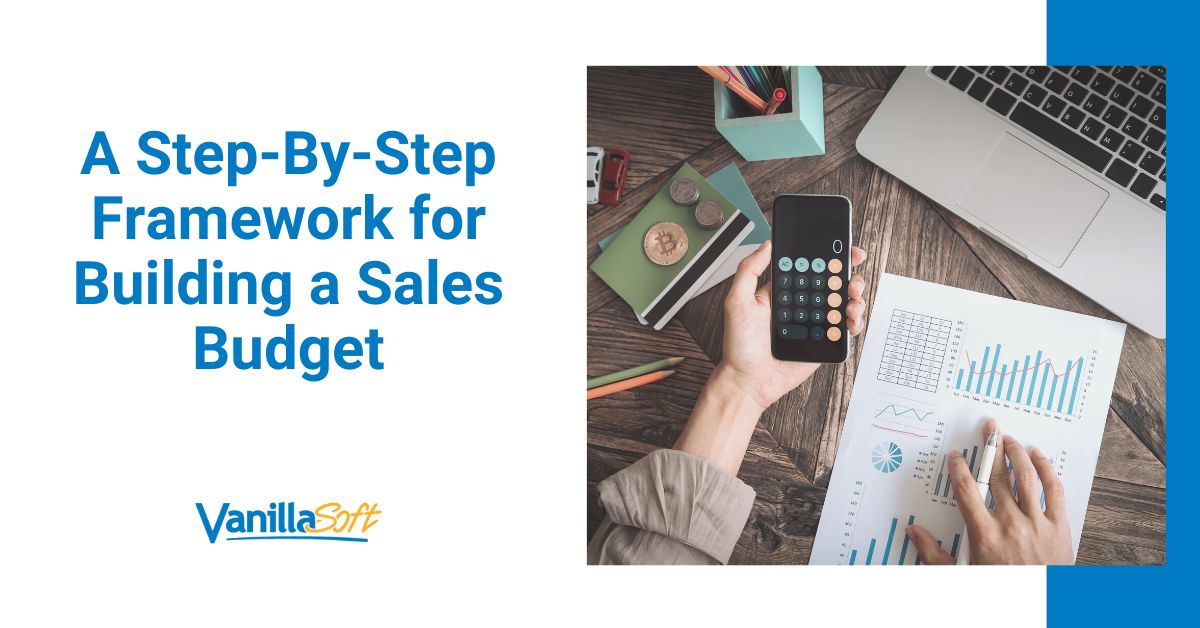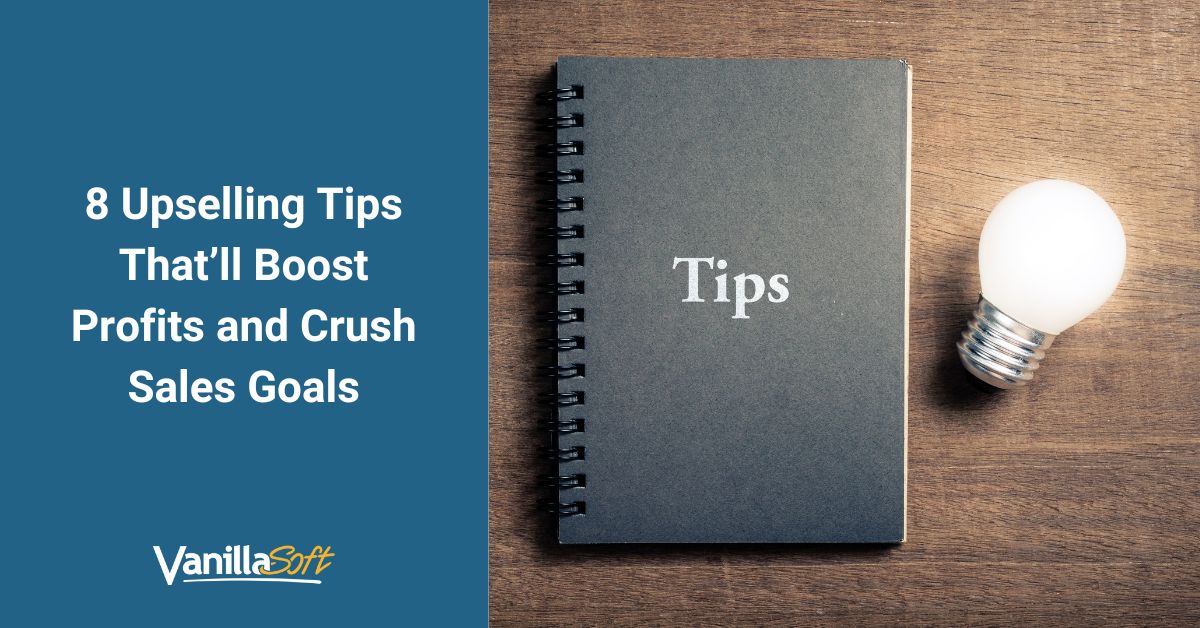
“Is this really your best offer?”
“Don’t you have any end-of-quarter promotions?”
“[Competitor] is offering the same thing for 30% less. Will you match?”
Does handling and overcoming price objections put a wrench in your process?
Any sort of price discussion will send the hairs on the back of a sales rep’s neck up as previously lost deals run through their heads.
Losing on pricing is brutal to the company and the sales representative – especially when it happens late in the cycle. So what can you do when it looks like you might be losing a deal on price?
The sad truth is – if you’re at the end of the deal cycle and you’re worried you’ll lose on price, you’ve probably already lost.
The only way to overcome price objections is by emphasizing value throughout the sales process, so when you’re engaging with a buyer who suddenly (or consistently) wants to talk price, you can keep the process moving.
4 Common Price Objections and Potential Reactions
- Budget
Are they lacking the budget for this period only, or is the price too high to ever be an option?
Sometimes the initial investment is too significant, but if you can offer a payment plan, it’s instantly made feasible. Another issue that can arise with the budget is that the prospect doesn’t see the value of the product.
Reaction:
If a payment plan isn’t enough to remedy budget problems and elicit a sale, ask if the budget will become available and circle back at that time.
The representative can also offer to repackage a new deal to meet their budget. This will reveal what features they can go without and which they must have.
Explain how the solution you’re selling is an investment in the company’s future. It’s not an expense like an office chair or a lamp, it will have an actual ROI.
If you can create a realistic formula to estimate the ROI – even better. Providing a dollar amount makes it more tangible, and the prospect can weigh out the value.
Going back to the worth of your product/service, invite the prospect to look at the cost of doing nothing or the cost of going to a cheaper competitor.
What will they be missing out on?
- Too expensive
Compared to what?
Expensive is a relative term, and the rep will need to find out how expensive they believe your product is.
This can open the doors for negotiation.
Reaction:
If the buyer believes you’re overpriced compared to competitors, ensure that they’re comparing apples to apples. If possible, get a copy of the competing proposal to make a comparison and review the included features line by line.
Doing so will reveal any major differences in the two offers and hopefully explain a portion of the price disparity.
Reassure them of the added value that comes with a higher price tag.
Perhaps it’s not a product detail or feature, but something related to the warranty or support they’ll receive from going with your brand.
Maybe your product has higher ratings than the competing product. Whatever your competitive advantages are, they should be presented to the buyer.
- Lacking features
Are there features that the purchaser has seen in similar products that yours is missing?
If so, the rep should work to find out if these are deal-breakers or a negotiation tactic on behalf of the buyer.
Reaction:
Play up features your brand is offering that others don’t.
Explain to the prospect that although we don’t have ‘x,’ we have ‘y’ that will provide more value to you in the long run.
If the feature in question is brought up by several prospects, the brand should consider a partnership with a stand-alone service that fills the gap or figure out how to get it on your product roadmap.
With a technology product or service, future plans to add the missing feature, and have it included later at no cost, could help to close the deal.
- Time
This factor can arise in several forms.
The prospect may not have the ability to be down when transitioning to new software, they may require an immediate return on investment, or they may not want to put in the time and effort to train employees on something new.
Time equals money, and these are reasonable objections. Sellers just need to know how to respond.
Reaction:
Here are a few responses based on the time objections noted above.
Assure the buyer that the downtime will be minimal.
Point out that they can continue with business as usual until it’s time to make the switch.
If possible, offer the option to finalize any transitions after hours.
Depending on your product, an immediate return may or may not be possible. Calculate what the return will be after one month, three months, six months, one year, etc.
Seeing these numbers laid out helps demonstrate value.
If your product will require training, explain how the time invested is worth it.
What is the cost of doing nothing?
Does it make sense to skip the purchase because a few hours will be spent on training?
Probably not.
If you’re selling a solution, it will likely save time in the future and have significant value.
How Value Transforms Objections Into Opportunities
Establish and Refine Value EARLY
Value is defined by the buyer – not by the salesperson
Avoiding or managing a price objection starts at the beginning. Specifically, it starts with a thorough discovery process where you make it a point to fully understand what motivates and drives your buyer.

It’s too easy to ask, “Are you experiencing this problem?” and list the top three-to-five issues your product solves.
The presence of a match does not mean your product is a real value add – it just means you know where to dive deeper. You need to know what the buyer thinks is the source of the problem, how they want it to be solved, and what the desired “end state” is.
Top sales reps will partner with their buyers to define what success looks like, but it’s a delicate balance of education and influence.
The buyer decides what is of value to them, and what isn’t. All we can do as sales professionals is hope to influence – but we must accept we do not control.
Differentiate or Die
Andy Grove famously said, “Adapt or die.”
When you’re building value, you must differentiate, or your deal will die.
The more you can separate what you offer from the status quo, your competition, or an alternate solution, the easier it is to control perceived value.
Simple supply and demand – the more scarce the solution, the higher the value (and typically the price!)
Use case studies, industry reports, testimonials – the more you can do to build up your product as unique, the easier it will be to avoid a bidding war with another product and justify your price point.
Don’t oversimplify your buyer’s needs
“What I hear you say is…” can be a dagger to the heart of your buyer.
Either because you nailed their pain – or because you missed it entirely.
It’s easy to hear a client mention “cost control” and turn that into “you’re looking to save money – we can help!”
Be wary.
If you make broad assumptions you risk alienating instead of building rapport. Focus on mirroring statements – repeat their own words back to them.
Every situation is nuanced, and each buyer is unique. While we all crave connection and validation of our problems, every buyer also wants a personal touch.
Resist the temptation to lump their needs into buckets, and it’ll pay dividends.
Know Your Own Value
Buyers have to ask for discounts – you don’t have to say yes
Imagine you’re buying a car. Do you accept the sticker price immediately, or do you ask if there’s anything they can do to lower the price just a bit?
Even if the dealership or person you’re buying from started off saying that number was their “best offer,” you still probably ask for some sort of deal.
It’s expected – nay required.
Now imagine you buy a product, and your boss asks if you negotiated the price. If you say “no,” you’re in trouble.
Buyers MUST ask for discounts, free upgrades, or something to feel like they’re getting the best deal they can.
However, just because they’re asking doesn’t mean you have to say “yes.” In fact, in many situations, the best thing you can do to build value is to refuse to discount.
There’s very little stronger than saying, “I get why you’d ask for that, but our prices are firm.
We set them so that everyone gets the best deal possible while maintaining the quality service we know you expect.”
Value is long term; price is short term
When a buyer comes at you with pricing adjustments, it’s important to understand what they’re looking for.
Do they have a hard ceiling on their budget they need you to get under?
Are they checking a box for their boss?
Are they already sold but looking to feel like they ‘won’ the negotiation?
Price is what they see right now – it shows up on the balance sheet nearly immediately. Value takes longer to show up and defines whether a product becomes essential or not.
Go back to the initial success criteria.
Remind the buyer how you will get them to that desired end state. Then figure out what’s driving the request. Once you have that, you can refocus on the long-term value.
Price is ONE detail of a deal
It’s a big detail, but a detail nonetheless.
Work with your boss and get creative with the deal structure and price point.
Can you get a testimonial out of a slight discount?
Can you throw in a new (untested) feature to make them feel special?
Can you change your net-30 to a net-90 so the client can pay in a different month?
Again – discovery is key. If you mapped out what matters properly, you’ll be able to know what variables of price can be played with to get the deal done.
Be Prepared If You’ve Previously Given Discounts
Most buyers will sniff out if you’ve given discounts before to other clients, or if you’ve offered an end-of-period discount, or if you have had sales.
Understanding this, buyers will rightly use your past discounting against you because clearly, you do have some wiggle room on price.
If your firm has engaged in these past behaviors then you need to be prepared to either defend your price and risk losing the deal or alternatively you need to meet the previous prices you offered.
Why?

Because when you previously discounted, you yourself established the real value of your own offering.
It’s not unreasonable for a buyer to want to buy at the lowest price regardless of how indignant you get or how you attempt to justify those past discounted offerings.
The buyer did not force you to previously drop your price.
Finally, buyers are savvy when it comes to these relatively subjective deadlines such as end-of-year special pricing.
As a seller, you may firmly believe that you cannot offer that same price two weeks into the new year, however the buyer is feeling disrespected and will intentionally choose to go elsewhere rather than feeling unheard, disrespected, unappreciated, or simply a transaction.
Confidence Is Key
Price will always come up as an objection or question at some point in the sales process. What is often overlooked is the delivery of the planned rebuttal.
Whenever pushing back on price, you have to be 100% confident in your product and its value to the buyer.
Your buyer will take their queue from you. Without being dismissive, you have to hold firm to what you know your product’s value is.
If you waver even a bit, it’s hard to claw that back.
Know what matters to the buyer – confirm it at every step in the process – and hold your ground.
When to Accept a ‘No’
Sometimes there’s no way around a price objection. In these cases, the lead was likely wrongly qualified. Improperly qualified leads can clog up your pipeline and waste your sales team’s valuable time. When qualifying leads at your organization, the budget should be one of the first factors considered. Even though many sales teams are moving away from the age-old BANT mantra from IBM, which begins with Budget, they are still keeping Budget in their qualification process.
As a manager, you must ensure that your sales team understands when to accept defeat and quit wasting any more time. Management should acknowledge to their representative that there was nothing more they could have done, and avoid pinning guilt on their inability to close the deal. Sometimes matters of price objection are truly out of their control, and no explanations or negotiation tactics will sway the prospect’s decision. Encourage your rep to stay positive and look forward to the next opportunity.
Handling Price Objections Boils Down to VALUE
Just like in any negotiation, you have to know when to walk away.
If you’re dealing with a buyer willing to not buy after you’ve made your best offer, the answer is NOT to drop your price.
It’s to push the value they’re getting, and if they still aren’t interested, then be willing to walk away or ask for help. You do no one any favors by selling your product below cost.
Have the confidence in yourself to trust the value of your product. That confidence will help you ask the right questions, overcome price objections, and close more.
The best way to establish value is to avoid any discounting, and the best way to ensure a positive customer experience is to respect the Buyer’s purchasing perspectives.
“Price is what you pay. Value is what you get.” Warren Buffet.



